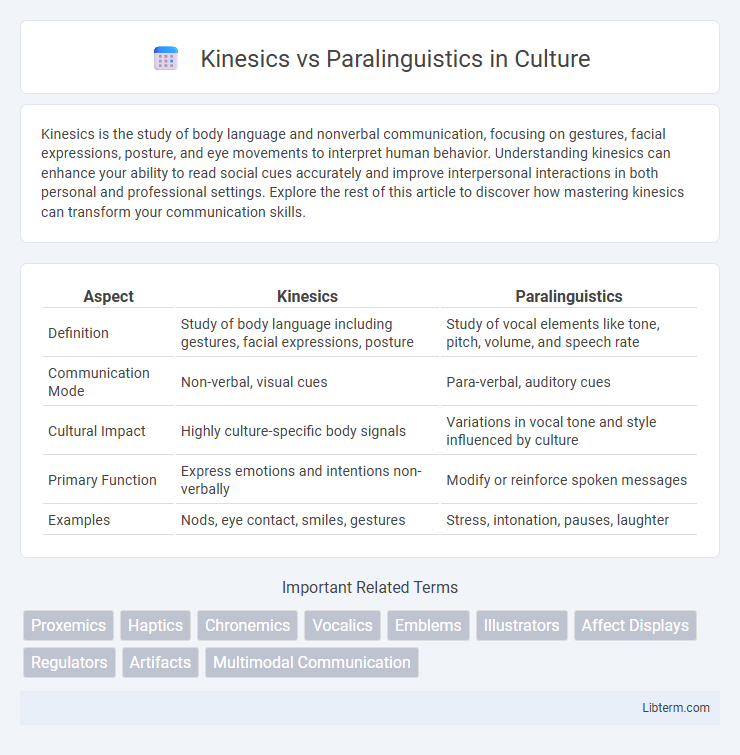Kinesics is the study of body language and nonverbal communication, focusing on gestures, facial expressions, posture, and eye movements to interpret human behavior. Understanding kinesics can enhance your ability to read social cues accurately and improve interpersonal interactions in both personal and professional settings. Explore the rest of this article to discover how mastering kinesics can transform your communication skills.
Table of Comparison
| Aspect | Kinesics | Paralinguistics |
|---|---|---|
| Definition | Study of body language including gestures, facial expressions, posture | Study of vocal elements like tone, pitch, volume, and speech rate |
| Communication Mode | Non-verbal, visual cues | Para-verbal, auditory cues |
| Cultural Impact | Highly culture-specific body signals | Variations in vocal tone and style influenced by culture |
| Primary Function | Express emotions and intentions non-verbally | Modify or reinforce spoken messages |
| Examples | Nods, eye contact, smiles, gestures | Stress, intonation, pauses, laughter |
Understanding Kinesics: The Language of Body Movements
Kinesics refers to the study of body movements, gestures, facial expressions, and postures as a form of nonverbal communication that conveys emotions and intentions without spoken words. Unlike paralinguistics, which involves vocal elements such as tone, pitch, and volume, kinesics focuses solely on physical behaviors that provide insight into a person's feelings and social signals. Mastering kinesics enhances interpersonal communication by interpreting unspoken messages through body language cues.
What Is Paralinguistics? Beyond Words in Communication
Paralinguistics refers to the vocal elements of communication that accompany speech, such as tone, pitch, volume, and speech rate, which convey meaning beyond the actual words spoken. Unlike kinesics, which involves body language and gestures, paralinguistics focuses on how something is said rather than what is said, influencing the emotional context and intent behind the message. Understanding paralinguistic cues enhances communication by revealing attitudes, feelings, and social cues that words alone cannot express.
Key Differences Between Kinesics and Paralinguistics
Kinesics involves the study of body movements, gestures, facial expressions, and posture as forms of nonverbal communication, while paralinguistics refers to the vocal elements of speech such as tone, pitch, volume, and speech rate. Kinesics conveys emotions and intentions through physical behavior, whereas paralinguistics modifies verbal messages by adding emphasis, attitude, and emotional context. The primary difference lies in kinesics focusing on visible bodily communication, whereas paralinguistics centers on vocal cues accompanying spoken language.
Types of Kinesics: Gestures, Posture, and Facial Expressions
Kinesics encompasses nonverbal communication through body movements such as gestures, posture, and facial expressions, each conveying specific emotional or contextual information. Gestures include hand signals and movements that illustrate or emphasize spoken words, while posture communicates attitudes, openness, or dominance within interactions. Facial expressions are fundamental in expressing emotions like happiness, anger, or surprise, often providing critical context beyond verbal language in social and professional communication.
Paralinguistic Features: Tone, Pitch, and Volume
Paralinguistic features such as tone, pitch, and volume play a critical role in conveying emotions and intentions beyond the literal meaning of words. Tone reflects the speaker's attitude, pitch variation signals questions or emphasis, and volume indicates urgency or confidence, all essential for effective communication. These vocal elements enhance message clarity and influence listener perception in interpersonal interactions.
The Impact of Kinesics on Interpersonal Communication
Kinesics, the study of body language including gestures, facial expressions, and posture, significantly influences interpersonal communication by conveying emotions and intentions beyond spoken words. Effective use of kinesic cues can enhance understanding, build rapport, and reduce misunderstandings in face-to-face interactions. Research indicates that nonverbal signals often carry more weight than verbal messages, making kinesics a critical factor in successful communication.
Cultural Variations in Kinesics and Paralinguistics
Cultural variations in kinesics reveal that gestures, facial expressions, and body language differ significantly across societies, influencing nonverbal communication in contexts such as greetings, personal space, and eye contact. Paralinguistics, encompassing vocal qualities like tone, pitch, and pauses, also exhibit cultural variation; for example, the use of silence or voice modulation can convey respect or assertiveness differently in Eastern versus Western cultures. Understanding these distinctions is crucial for effective intercultural communication and avoiding misunderstandings rooted in nonverbal cues.
How Kinesics and Paralinguistics Influence Meaning
Kinesics involves body language such as gestures, facial expressions, and posture, which provide nonverbal cues that shape the interpretation of spoken messages by conveying emotions and attitudes. Paralinguistics refers to vocal elements like tone, pitch, volume, and speech rate, which influence the meaning of words through variations in how something is said rather than what is said. Together, kinesics and paralinguistic features enrich communication by adding layers of meaning beyond the literal words, helping to clarify intent and emotional context.
Practical Applications in Everyday Interactions
Kinesics, which studies body language such as gestures, facial expressions, and posture, plays a crucial role in interpreting emotions and intentions during face-to-face communication, enhancing interpersonal understanding. Paralinguistics involves vocal elements like tone, pitch, and volume that modify spoken messages and provide context beyond words, crucial for conveying sarcasm, urgency, or sincerity. Combined, kinesics and paralinguistics improve practical communication in settings like negotiations, customer service, and conflict resolution by enabling accurate interpretation of both verbal and nonverbal cues.
Enhancing Communication: Integrating Kinesics and Paralinguistics
Integrating kinesics, which involves body language such as facial expressions and gestures, with paralinguistics, including tone, pitch, and volume of voice, significantly enhances communication effectiveness. This combination provides a richer, multi-layered context that helps accurately convey emotions and intentions, reducing misunderstandings. Mastering both aspects allows for more persuasive interpersonal interactions and improved interpretation of nonverbal cues in diverse communication settings.
Kinesics Infographic

 libterm.com
libterm.com